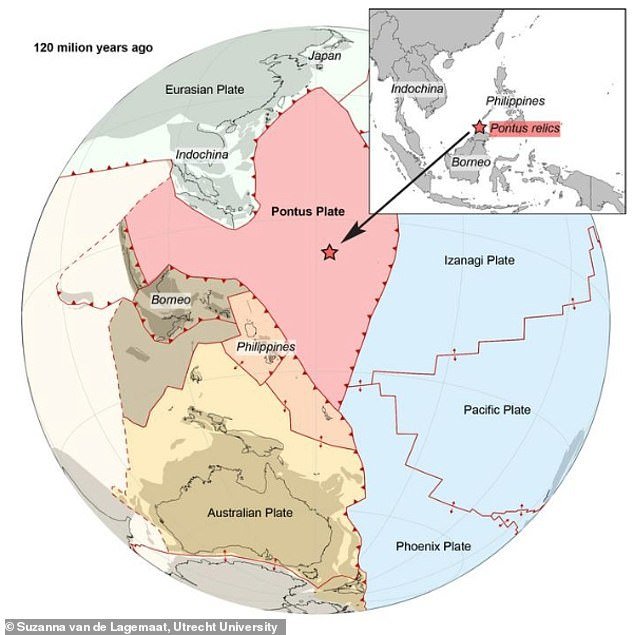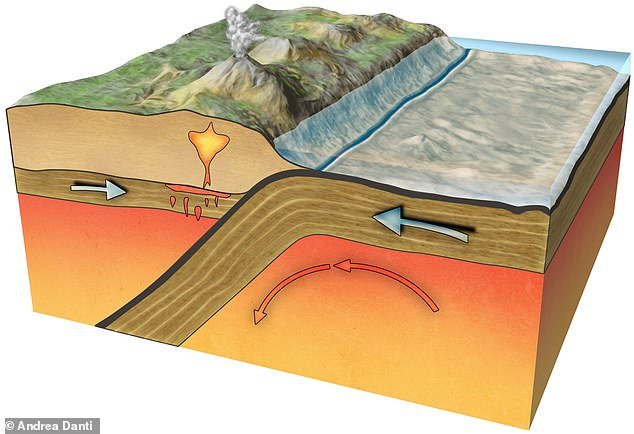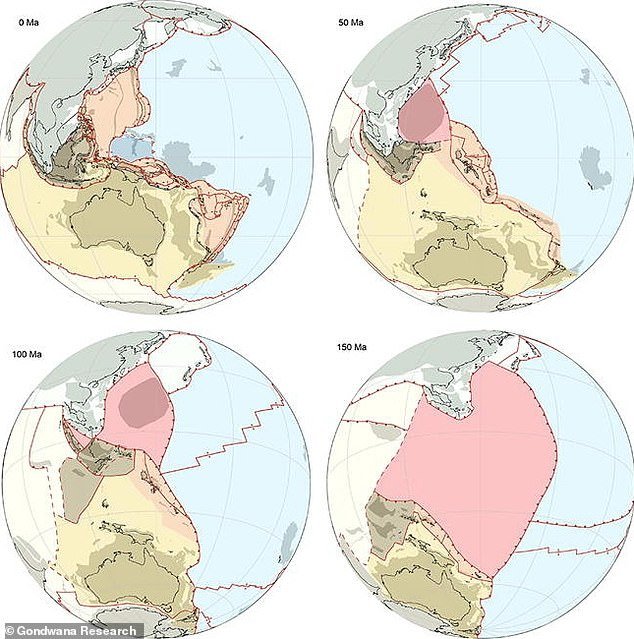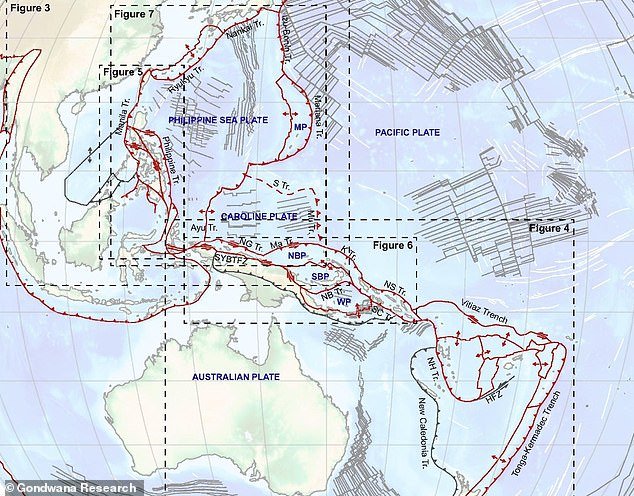Long-lost tectonic ‘MEGA-PLATE’ is discovered after 160 million years: Incredible map reveals Pontus was once one-quarter the size of the Pacific Ocean
Scientists have identified a long-lost tectonic plate in the western Pacific Ocean.
Called Pontus, the ‘mega-plate’ was once 15 million square miles, about a quarter the size of the Pacific Ocean today.
But she it Was slowly sunk and lost over millions of years, pulled down under a neighboring plate by gravity.
Pontus existed as early as 160 million years ago and up to 20 million years ago, although by this time its size would have been significantly reduced.
The researchers used computer modeling and studied oceanic rocks, described as “relics of Pontus”, to identify the plate and its movement.

Pictured is the location of the Pontus plate in the paleo-Pacific ocean 120 million years ago. The oceanic rocks, described as ‘Pontian relics’, revealed the presence of the plate to researchers, who say it was ‘abducted’ and lost over millions of years.
The findings are detailed in a new study led by Suzanna Van de Lagemaat, a PhD candidate in plate tectonics at Utrecht University in the Netherlands.
“There are many plates that were once on the surface of the Earth and no longer exist,” she told MailOnline.
“In my model, which goes back to 160 million years ago, Pontus exists at that time, but it could be even older.
It finally disappeared about 20 million years ago, so it was on Earth’s surface for at least 140 million years, but most likely longer.
It is well known that the Earth’s lithosphere – its rocky, outermost shell – is currently made up of about 15 tectonic plates, each of different shapes and sizes.
Strong seismic activity can be detected along tectonic plate boundaries, where plates rub against each other, causing earthquakes.
But in the ancient geological past, large plates have since disappeared into the Earth’s mantle by ‘subduction’.
This is the geological process in which one edge of one lithospheric plate is forced under the edge of another – and over time an entire plate can be lost.
More importantly, a subducted plate leaves behind traces when it ‘sinks’ into the Earth’s mantle – that is, fragments of rock hidden in mountain ranges.
“The discount is an ongoing process,” Van de Lagemaat told MailOnline.
“The subducting plate is actually denser than the surrounding mantle, so gravity basically pulls the plate down into the mantle.
“During the process of subduction, however, the upper parts of the subducting plate are sometimes scraped off—a bit like a cheese grater that picks up only a very small slice of cheese.”

In subduction zones, the Earth’s tectonic plates converge and one plate sinks under another (photo)

Pontus is highlighted in pink at different time periods – 50 million years ago, 100 million years ago and 150 million years ago
For the study, Van de Lagemaat and colleagues looked at Earth’s most complex plate tectonic region – the area around the Philippines.
This is described as a ‘complex junction’ of different plate systems where several plate boundaries meet.
“The region consists almost entirely of oceanic crust, but some parts are raised above sea level and show rocks of very different ages,” Van de Lagemaat said.
The team used geological data to reconstruct the current plate movements with computer modeling, which hinted at a wide area that could be freed by a subducting plate.
But northern Borneo also provided ‘the most important piece of the puzzle’ – oceanic rocks, described as ‘relics of Pontus’, made of basalt.
Using magnetic techniques, the researchers determined that the basalts from Borneo were relics of Pontus left behind when this part of the plate sank, about 85 million years ago.
“Basalt itself was formed 135 million years ago and when basalt forms, it stores information about the magnetic field that was present when the rock was formed,” Van de Lagemaat told MailOnline.
Based on the ancient magnetic field preserved in the rocks, we can infer at what latitude the rock formed 135 million years ago.
“When we model the movement of the basalt piece between 85 million years ago (when it arrived in Borneo and was submerged) and 135 million years ago (when it formed), we get information about the movement of the entire plate.
“This motion does not match previously known plate motion in the same time interval.
“That means we’re dealing with a previously unknown dish.”

For the study, the researchers looked at Earth’s most complex plate tectonic region — the area around the Philippines
The “rock relics of Pontus” are not only found in northern Borneo, but also in Palawan, an island in the Western Philippines and in the South China Sea, the team says.
Experts from the University of Utrecht had predicted the existence of Pontus more than 10 years ago, based on fragments of old tectonic plates found deep in the Earth’s mantle, but now the hypothesis has been resolved.
Such subducted plate fragments (lost in the Earth’s mantle) can be traced on Earth to the core-mantle boundary, which is about 2900 below the Earth’s surface.
“These fragments can be identified using a technique called seismic tomography, which uses seismic waves emitted by earthquakes,” Van de Lagemaat told MailOnline.
“These waves are picked up by seismographs located everywhere.
“If there is a difference between the expected arrival time and the actual arrival time of a seismic wave, this suggests that there is an anomaly in the mantle.
“Over time, this provides a lot of data about all the earthquakes and their waves that are picked up by all these seismographs, which enables a 3D model of the Earth’s mantle to be built.”
Understanding the movements of the tectonic plates that make up Earth’s solid outer layer is essential to understanding the planet’s geological history, the team concludes.
The new study is published in the journal Gondwana Exploration.
(tagsTranslate) daily mail(s) sciencetech(s) Japan(s) Earth(s) Netherlands(s) New Zealand

